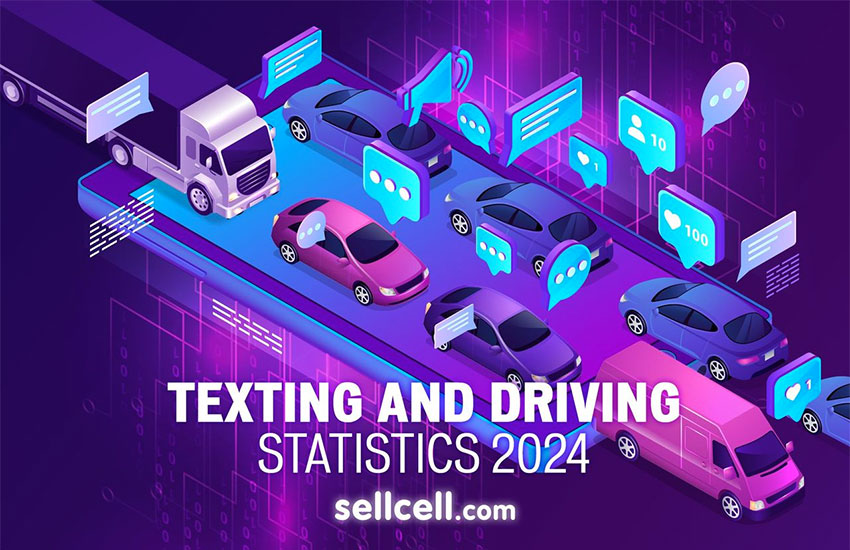Last updated January 24, 2024
Find a wide range of texting and driving statistics, showing what happens when we are distracted by texting when driving, how many accidents are caused by texting and driving, and which age groups are the worst culprits for the practice of texting while driving.
This article will offer a statistical analysis of texting and driving data.
You can find out texting and driving statistics for the USA, Canada, and the United Kingdom.
The article also contains a plethora of other facts relating to the act of texting while driving.
In this article, you will discover a comprehensive range of texting and driving data. Texting and driving is a serious issue, and one that causes far too many car accidents. Texting while driving is distracting, which obviously means while you concentrate on your phone, you’re not looking at the road. With so many people sending texts every day, and so many people driving, accidents are bound to happen. Let’s look at the data around texting while driving (and more)…
Menu: Jump to a section
- SellCell Key Findings
- Why You Shouldn't Text and Drive
- Texting and Driving: The Statistics
- Texting and Driving Fatalities in the USA
- Texting and Driving Fatalities in the USA by Age Group
- Crashes Related to Driver Cellphone Use
- Texting and Driving vs. Alcohol Related Accidents in the USA
- Texting and Driving Fatalities in the UK
- Texting and Driving Accidents in the UK
- Mobile Phone Use While Driving in the UK
- Mobile Phone Use While Driving in the UK, by Vehicle Type
- Mobile Phone Use While Driving in the UK, by Age
- Mobile Phone Use While Driving in the UK, by Gender
- Contributing Factors to Fatal Collisions: Canada
- Texting and Driving Statistics Worldwide
- Argentina
- Australia
- Austria
- Belgium
- Chile
- Colombia
- Czech Republic
- Denmark
- Finland
- France
- Germany
- Ireland
- Italy
- New Zealand
- Nigeria
- Norway
- Poland
- Spain
- Switzerland
- Attitudes to Using a Phone While Driving
- Texting and Driving Statistics: Just Don't Do It
- Sources
SellCell Key Findings:
- The number of fatal accidents caused by texting while driving in the US has fallen year-on-year, from 496 in 2016, to 382 in 2021.
- In the US, those aged 15-20 are more responsible for fatal accidents when texting while driving than any other age group. This age group causes 17% of fatal accidents.
- The figures are significantly worse for all accidents (not just fatal accidents). In 2021, there were 64,910 accidents in the US caused by texting while driving.
- Alcohol is still a significantly bigger contributor to road traffic accidents. In the US in 2021, there were 382 fatal crashes linked to cell phone use. There were 12,192 fatal car crashes because of alcohol use.
Why You Shouldn’t Text and Drive
It goes without saying, but texting and driving is a dangerous combination that significantly increases the risk of accidents and fatalities on the road, as our texting and driving statistics—below—show. When you text behind the wheel, your attention is divided between the road and your phone screen, impairing your ability to react quickly to sudden changes in traffic or road conditions. This distraction can lead to delayed response times, increased chances of collisions, and jeopardizes the safety of both the driver and others on the road.
Moreover, texting while driving is a form of impaired driving, akin to driving under the influence of alcohol or drugs. Texting drivers can exhibit similar impairment levels as those with a blood alcohol content above the legal limit. The cognitive demands of texting divert attention from crucial driving tasks, impairing coordination, decision-making, and situational awareness. To ensure the safety of all road users, it is imperative to prioritize undivided attention to driving and refrain from engaging in activities like texting that compromise one’s ability to operate a vehicle safely.
Texting and Driving: The Statistics
So, we know we shouldn’t text and drive; it shouldn’t take SellCell to tell you this is a bad idea. Even so, people still do it. Let’s look at the harrowing data surrounding texting and driving at the same time. This makes for some grim reading, and SellCell would like to issue a trigger warning to anyone reading on, as the issues dealt with in this article include sensitive subjects.
Texting and Driving Fatalities in the USA
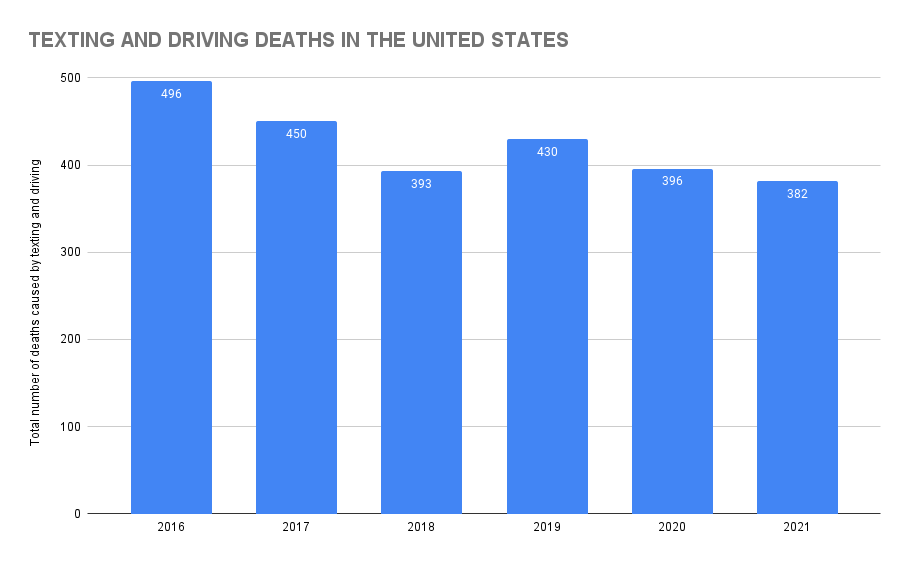
| TEXTING AND DRIVING DEATHS IN THE UNITED STATES | |
|---|---|
| Total number of deaths caused by texting and driving | |
| 2016 | 496 |
| 2017 | 450 |
| 2018 | 393 |
| 2019 | 430 |
| 2020 | 396 |
| 2021 | 382 |
- As the data above shows, back in 2016, there were 496 recorded fatal car accidents in the USA related to texting while driving.
- This number dropped in 2017, to 450 deaths, and again in 2018, to 393. However, we see a spike back up to 430 fatalities in 2019.
- The figures fell during 2020 (396 deaths) and 2021 (382 deaths). However, this is likely because of COVID lockdowns being in play during those two years. Even then, the number hasn’t decreased dramatically.
Texting and Driving Fatalities in the USA by Age Group
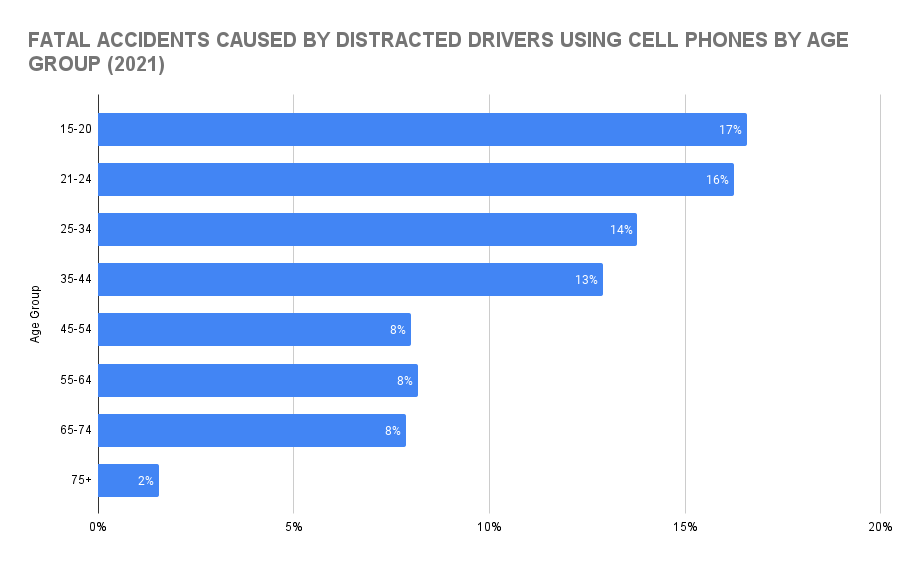
| FATAL ACCIDENTS CAUSED BY DISTRACTED DRIVERS USING CELL PHONES BY AGE GROUP (2021) | |
|---|---|
| Age Group | Percentage of Distracted Drivers Using Cell Phones |
| 15-20 | 17% |
| 21-24 | 16% |
| 25-34 | 14% |
| 35-44 | 13% |
| 45-54 | 8% |
| 55-64 | 8% |
| 65-74 | 8% |
| 75+ | 2% |
- The worst culprits for causing fatal accidents while texting and driving is 15-20. People in this age group caused 17% of all accidents through cell phone distraction.
- Ages 21-24 aren’t much better. This age group caused 16% of all fatal accidents because they were texting while driving.
- Ages 75+ cause the least fatal accidents because of texting while driving. This age group only accounts for 2% of fatal crashes caused in this way.
Crashes Related to Driver Cellphone Use
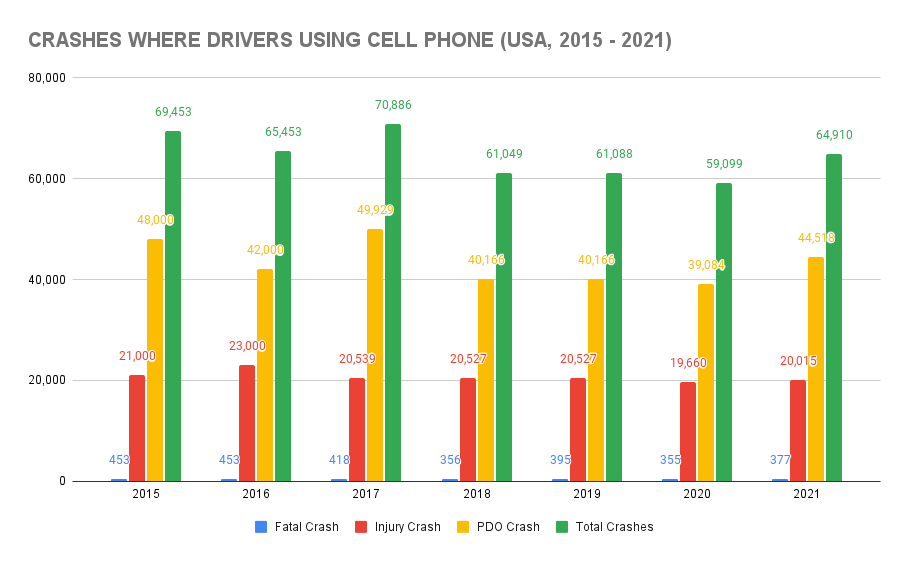
| CRASHES WHERE DRIVERS USING CELL PHONE (USA, 2015 – 2021) | ||||
|---|---|---|---|---|
| Fatal Crash | Injury Crash | PDO Crash | Total Crashes | |
| 2015 | 453 | 21,000 | 48,000 | 69,453 |
| 2016 | 453 | 23,000 | 42,000 | 65,453 |
| 2017 | 418 | 20,539 | 49,929 | 70,886 |
| 2018 | 356 | 20,527 | 40,166 | 61,049 |
| 2019 | 395 | 20,527 | 40,166 | 61,088 |
| 2020 | 355 | 19,660 | 39,084 | 59,099 |
| 2021 | 377 | 20,015 | 44,518 | 64,910 |
- The latest data from the NHTSA shows that in the USA in 2021 there were 64,910 total crashes in which the driver of the vehicle was using a cellphone while driving. 377 of these were fatal crashes.
- The total crashes figure was highest in 2017, when there was a total of 70,886 accidents, of which 418 were fatal.
- The highest number of fatal accidents took place in 2015 and 2016, both of which had 453 fatal crashes related to driver phone use.
Texting and Driving vs. Alcohol Related Accidents in the USA
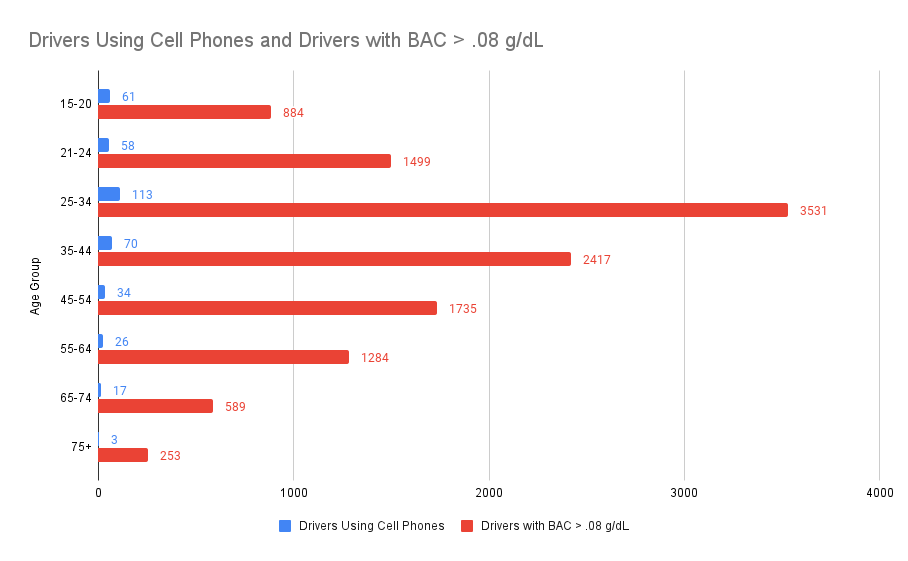
| Drivers Using Cell Phones and Drivers with BAC > .08 g/dL | ||
|---|---|---|
| Age Group | Drivers Using Cell Phones | Drivers with BAC > .08 g/dL |
| 15-20 | 61 | 884 |
| 21-24 | 58 | 1499 |
| 25-34 | 113 | 3531 |
| 35-44 | 70 | 2417 |
| 45-54 | 34 | 1735 |
| 55-64 | 26 | 1284 |
| 65-74 | 17 | 589 |
| 75+ | 3 | 253 |
- The above data shows the number of accidents caused by people distracted by their cell phone vs. people under the influence of alcohol. More specifically, it is people considered over the legal limit for alcohol consumption. We consider drivers being alcohol impaired when their blood alcohol concentration (BAC) is .08 g/dL or higher.
- In the 15-20 age group, there were 61 accidents in 2021 caused by texting while driving. Comparatively there were 884 accidents caused by alcohol impairment.
- The worst age group for both cell phone distraction and alcohol impairment in 2021 was 25-34. They caused 113 texting while driving accidents, but a massive 3531 accidents because of alcohol impairment.
- In total, across all age groups, there was a total of 12,192 fatal car crashes because of alcohol use, compared to 382 using phones.
- This shows that alcohol is still the biggest culprit for causing car accidents.
Texting and Driving Fatalities in the UK
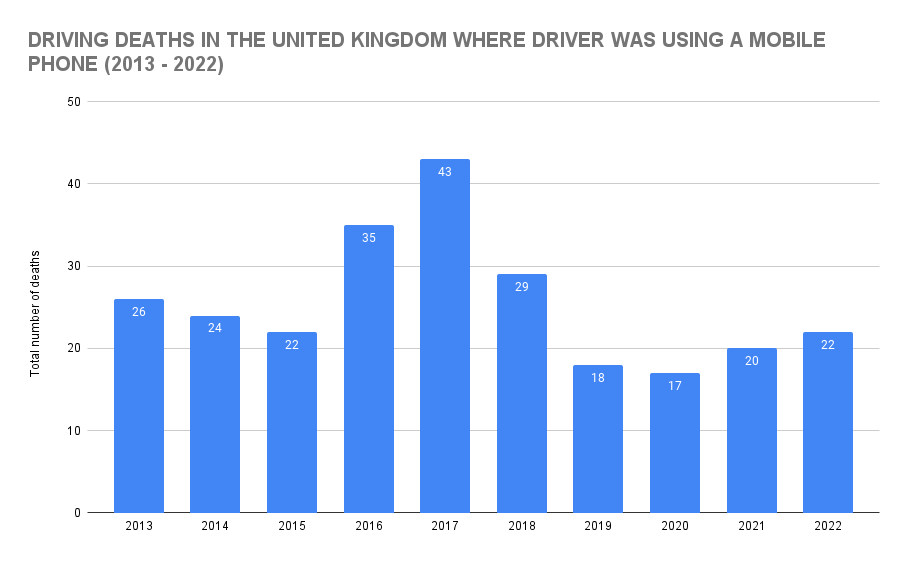
| DRIVING DEATHS IN THE UNITED KINGDOM WHERE DRIVER WAS USING A MOBILE PHONE (2013 – 2022) | |
|---|---|
| Total number of deaths where driver using a mobile phone | |
| 2013 | 26 |
| 2014 | 24 |
| 2015 | 22 |
| 2016 | 35 |
| 2017 | 43 |
| 2018 | 29 |
| 2019 | 18 |
| 2020 | 17 |
| 2021 | 20 |
| 2022 | 22 |
- In 2013, the number of deaths in the UK related to mobile phone use was 26. In the two years following, it dropped to 24 and 22, respectively.
- The numbers started rising in 2016, with a sharp jump up to 35, and then 2017 saw the highest number yet, with 43.
- 2020 saw the lowest number, with 17 deaths caused by phone distraction. In 2022, the number had risen yet again, to 22.
Texting and Driving Accidents in the UK
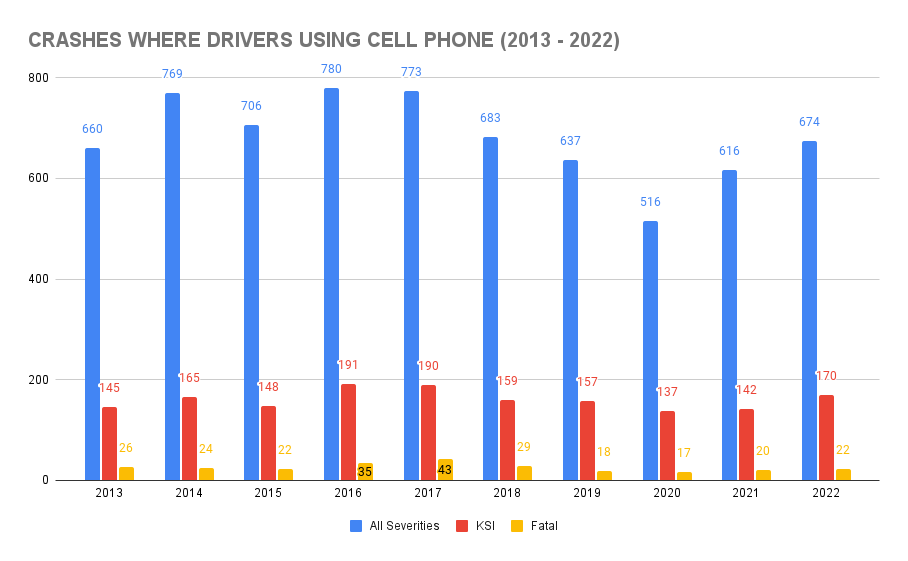
| CRASHES WHERE DRIVERS USING CELL PHONE (2013 – 2022) | |||
|---|---|---|---|
| All Severities | KSI | Fatal | |
| 2013 | 660 | 145 | 26 |
| 2014 | 769 | 165 | 24 |
| 2015 | 706 | 148 | 22 |
| 2016 | 780 | 191 | 35 |
| 2017 | 773 | 190 | 43 |
| 2018 | 683 | 159 | 29 |
| 2019 | 637 | 157 | 18 |
| 2020 | 516 | 137 | 17 |
| 2021 | 616 | 142 | 20 |
| 2022 | 674 | 170 | 22 |
- The data above shows all crashes of all severities, compared with crashes where people were killed or seriously injured (KSI), and fatal crashes. These were all accidents caused by cell phone use while driving in the UK.
- While there may have been a relatively low yet totally avoidable 26 deaths in 2013, caused by texting while driving, there were 660 accidents caused by cell phone use. If we remove the 26 fatalities from the KSI statistic for 2013 (145 people KSI), that leaves 119 people who were seriously injured.
- In 2022, there were 674 total accidents relating to phone use while driving. 170 of them were KSI, and there were 22 fatalities
Mobile Phone Use While Driving in the UK
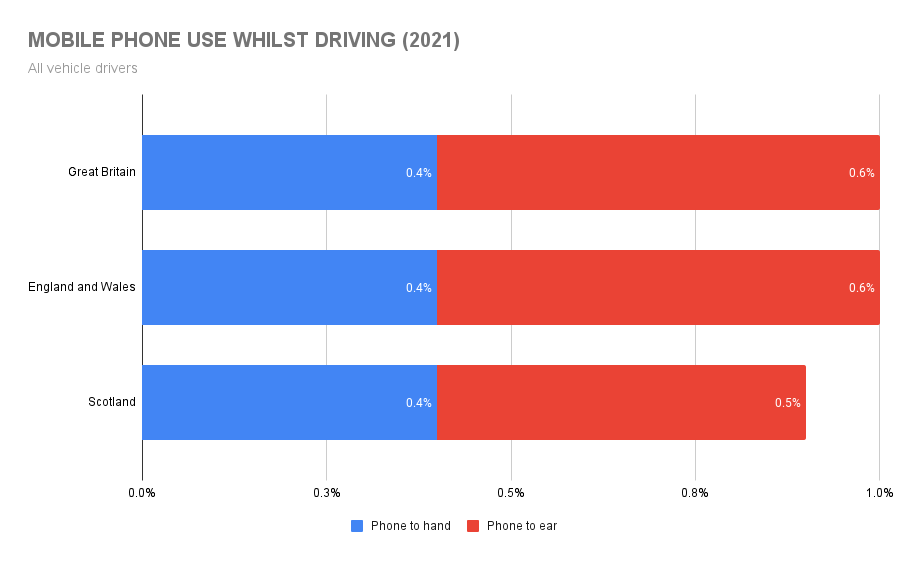
| MOBILE PHONE USE WHILST DRIVING (2021) | |||
|---|---|---|---|
| Phone to hand | Phone to ear | Hand held phone | |
| Great Britain | 0.4% | 0.6% | 1.0% |
| England and Wales | 0.4% | 0.6% | 1.0% |
| Scotland | 0.4% | 0.5% | 0.9% |
- According to UK government statistics on mobile phone use while driving, 1.0% of all observed drivers were seen operating a mobile phone.
- Across Great Britain, the split is 0.4% of drivers were seen with their phone in their hand and 0.6% had their phone to their ear.
Mobile Phone Use While Driving in the UK, by Vehicle Type
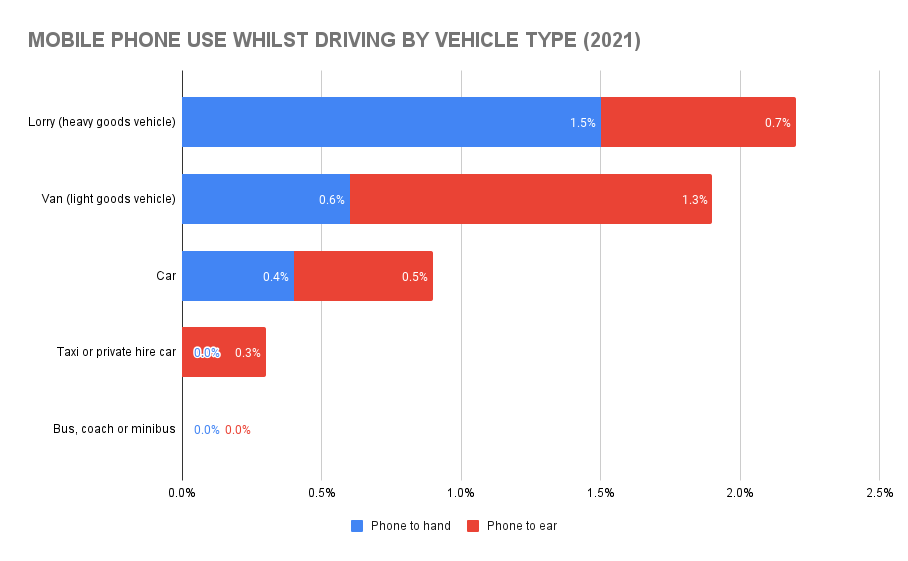
| MOBILE PHONE USE WHILST DRIVING BY VEHICLE TYPE (2021) | |||
|---|---|---|---|
| Vehicle Type | Phone to hand | Phone to ear | Hand held phone |
| Lorry (heavy goods vehicle) | 1.5% | 0.7% | 2.2% |
| Van (light goods vehicle) | 0.6% | 1.3% | 1.9% |
| Car | 0.4% | 0.5% | 0.9% |
| Taxi or private hire car | 0.0% | 0.3% | 0.3% |
| Bus, coach or minibus | 0.0% | 0.0% | 0.0% |
- HGV drivers are the worst culprits for phone use while driving in the UK. 1.5% of them were observed with their phone in their hand, and 0.7% with their phone to their ear. Considering the size of an HGV, this is by far the most dangerous instance of phone use while driving.
- Vans (surprise surprise) come second, with 0.6% of their drivers holding the phone in their hand, and 1.3% blatantly holding their phone to their ear.
- Bus/coach/minibus drivers are very conscientious, with not one of them observed breaking the law when it comes to phone use while driving.
Mobile Phone Use While Driving in the UK, by Age
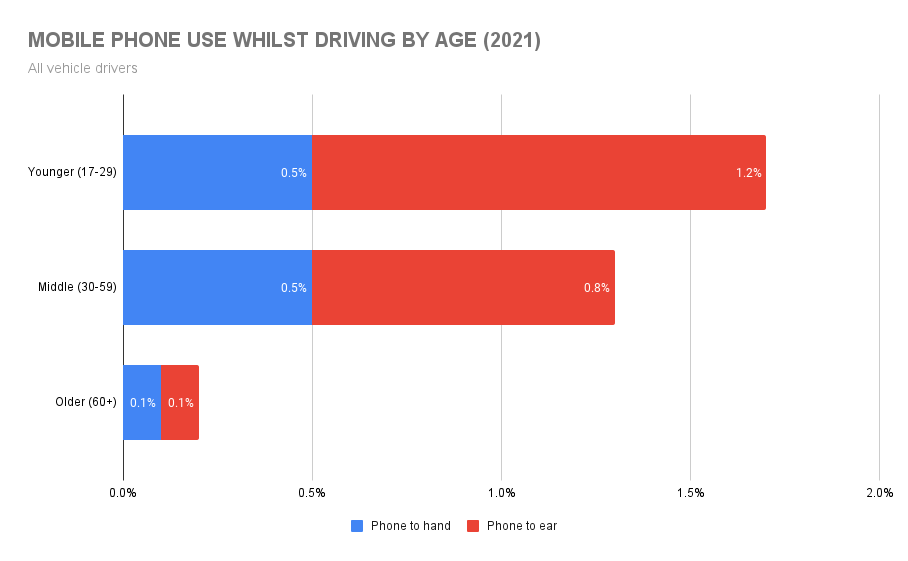
| MOBILE PHONE USE WHILST DRIVING BY AGE (2021) | |||
|---|---|---|---|
| Phone to hand | Phone to ear | Hand held phone | |
| Younger (17-29) | 0.5% | 1.2% | 1.7% |
| Middle (30-59) | 0.5% | 0.8% | 1.3% |
| Older (60+) | 0.1% | 0.1% | 0.2% |
- Young people are the least responsible in terms of phone use when in command of a vehicle. Of those aged 17-29, 0.5% were observed with their phone in their hand, while 1.2% were observed with their phone to their ear.
- Those aged 30-59 aren’t much better, with 0.5% of them holding their phone in their hand, and 0.8% holding their phone to their ear.
- The older generations (60+) use their phones least when driving, with only 0.1% observed for both having their phone in the hand, and phone to their ear.
Mobile Phone Use While Driving in the UK, by Gender
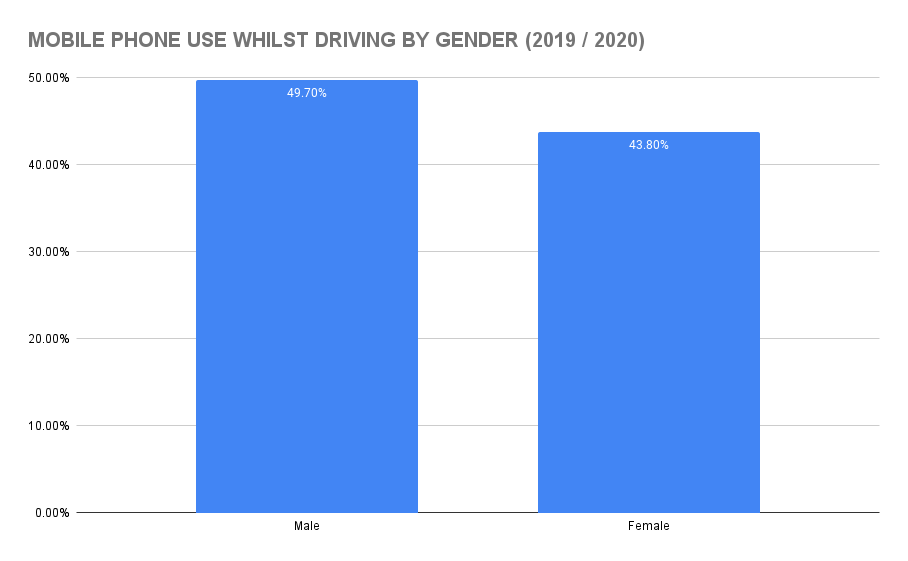
| MOBILE PHONE USE WHILST DRIVING BY GENDER (2019 / 2020) | |
|---|---|
| Mobile phone use | |
| Male | 49.70% |
| Female | 43.80% |
- Males are the worst culprits for phone use while driving in the UK. 49.70% of those observed using their phone in the car were male.
- Females aren’t doing much better, though. 43.80% of those observed using a phone while driving were female.
Contributing Factors to Fatal Collisions: Canada
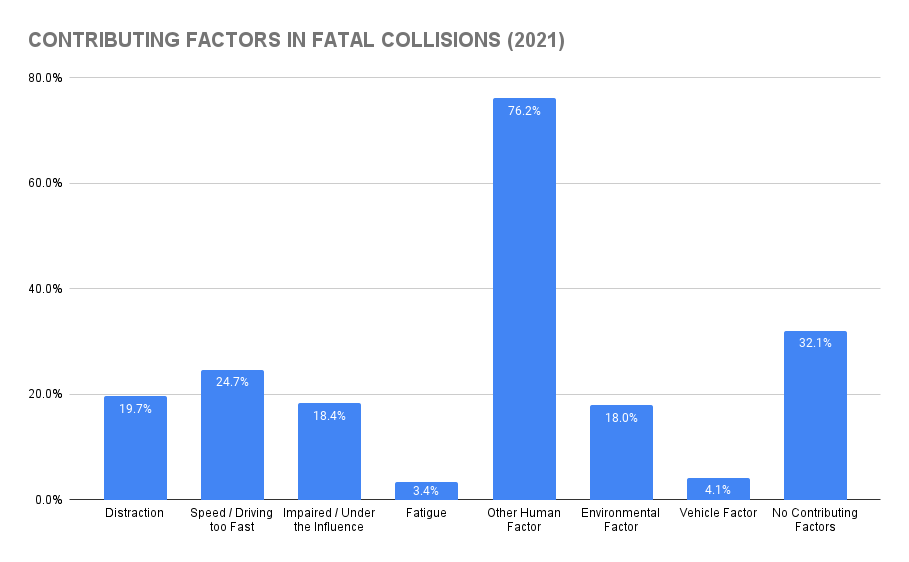
| CONTRIBUTING FACTORS IN FATAL COLLISIONS (2021) | |
|---|---|
| Contributing Factors* | |
| Distraction | 19.7% |
| Speed / Driving too Fast | 24.7% |
| Impaired / Under the Influence | 18.4% |
| Fatigue | 3.4% |
| Other Human Factor | 76.2% |
| Environmental Factor | 18.0% |
| Vehicle Factor | 4.1% |
| No Contributing Factors | 32.1% |
| * There will be double counting because there are multiple contributing factors reported for most collisions ** NOTE: These data were estimated using submissions from a subset of Canada’s provinces and territories. | |
- Little data exists relating to texting while driving in Canada. The above data is from Canadian collision statistics.
- The data shows “distraction caused” 19.7% of fatal collisions, and mobile phone use while driving would fall under this category.
Texting and Driving Statistics Worldwide
While global data isn’t as telling as the data from the US and the UK, International Transport forum texting and driving statistics from around the world show that it is very much a global issue. All data is taken from source 8.
Argentina
Distraction poses a growing challenge to traffic safety in Argentina. In 2018, a comprehensive nationwide observational analysis, drawing from a sample exceeding 95,000 cars, revealed that, at any given time, 16.8% of car drivers were engaged in distracting activities. The primary source of distraction was identified as mobile phone usage while driving a car (9.4%).
Australia
The increased reliance on mobile phones and other devices has raised concerns about distracted driving in Australia. However, there is no official definition for “distracted driving” in national statistics. Mobile phone use, in particular, is worrisome. In 2020, there were 56,232 reported infringements, a 41.7% decrease from 2019. It is illegal to use a handheld phone while driving in Australia.
Austria
In 2020, Austria’s road crash data showed that 21.5% of road deaths were likely because of distraction, like not paying attention or missing other road users. This was lower than the 24% recorded in 2019. Mobile phone use is considered a distracting factor.
Belgium
In Belgium, a growing issue for traffic safety is distraction, like using mobile phones while driving. It’s against the law to use handheld phones while driving, but using hands-free devices is allowed. In 2015, a quick survey in three large Belgian cities found that 7% of car drivers and 9% of light goods vehicle drivers used their mobile phones while waiting at traffic lights.
Chile
In 2020, police data showed distracted driving caused 223 road deaths (12.5% of all deaths) and 1,744 serious injuries. Fatalities went up by 33%, but serious injuries decreased by 5% compared to 2019. Chilean traffic law sees driving with a mobile phone, unless hands-free, as a serious violation.
Colombia
In Colombia, a growing issue for traffic safety is distraction, like using mobile phones while driving or walking. However, there aren’t official stats on how common distraction is in crashes. It’s against the rules to drive with a handheld phone, but using hands-free phones is allowed.
Czech Republic
In the Czech Republic, a rising issue for traffic safety is distraction, like using mobile phones while driving. It’s against the law to drive with a handheld phone or other electronics, but using hands-free devices is allowed. In 2020, about 2% of drivers were estimated to use a mobile phone while driving.
Denmark
Distraction is believed to play a part in 38% of deadly crashes in Denmark. Detailed crash studies reveal that distraction is a problem when driving a vehicle. Using a handheld mobile phone while driving is against the law in Denmark, but using hands-free devices is allowed.
Finland
In Finland, you can’t drive with a handheld phone, but using hands-free devices is okay. About three deadly crashes each year are linked to using a mobile phone while driving.
France
In France, traffic safety faces a growing issue: distraction, like using mobile phones while driving. In 2020, about 13% of deadly crashes happened because of distracted attention. It’s against the rules to drive with a handheld phone, but using hands-free phones is permitted.
Germany
In Germany, using a handheld phone while driving is against the law. Studies check how many drivers use smartphones, through the use of roadside observations. The first study in 2019 showed 3% of car drivers use their smartphones, 2% type with at least one hand off the wheel, and 1% talk on the phone, with about half of them holding it.
Ireland
In Ireland, distraction, especially from using mobile phones while driving, is becoming a bigger traffic safety issue. Rules against using mobile phones while driving started in May 2014. It’s considered an offense to hold a mobile phone while driving. A survey in 2018 found that out of 14,221 drivers observed, 8% were using their mobile phones (4% holding it to their ear and 4% in their hand).
Italy
In Italy in 2020, distraction was thought to be the main reason for 15.7% of road crashes—13.9% in cities and 20.6% on highways. Penalties for not following Article 173 of the Italian Highway Code, related to phone use, decreased less than usual in 2020. Traffic and local police data show that 98% of these penalties were because people were using phones and smartphones incorrectly while driving.
New Zealand
In New Zealand in 2019, driver distraction played a part in 15 deadly crashes (5% of 300), 133 serious injury crashes, and 932 minor injury crashes. Even though using mobile phones while driving is against the law in New Zealand, it’s still an issue, with 60% of drivers admitting to doing it.
Nigeria
In Nigeria, distraction, like using mobile phones while driving, remains an issue. In 2016, about 0.3% of deadly crashes were thought to be because of using a phone while driving. Driving with a mobile phone, even with hands-free devices, is against the rules in Nigeria.
Norway
In Norway, the law says mobile phones must be properly fixed on the car’s instrument panel, close to the driver. Hands-free devices are allowed. In 2019, out of 50 deadly crashes, some kind of distraction played a part, and five of those were because of using mobile phones.
Poland
In Poland, it’s against the law to use hand-held mobile phones while driving, but hands-free phones are allowed. A survey in 2016 found that about 4% of drivers in cars use hand-held mobile phones.
Spain
Distraction played a role in 17% of injury crashes and 31% of deadly crashes in Spain in 2020. It’s a bigger problem outside cities (37% of deadly crashes). Since 2002, using hand-held phones while driving has been against the rules; only hands-free phones are allowed.
Switzerland
In Switzerland in 2020, distraction, such as that from smartphones, was the main reason for 12% of deadly crashes. The BFU carried out a survey for the first time that year, and it found that almost 30% of drivers get distracted while driving, mainly by talking to passengers, and 5% by using a cellphone.
Attitudes to Using a Phone While Driving
So, we know people are using their phones, and the texting and driving statistics speak for themselves. However, what do people think about using a phone while they are in charge of a vehicle?
“I often check my messages on the mobile phone while driving.”
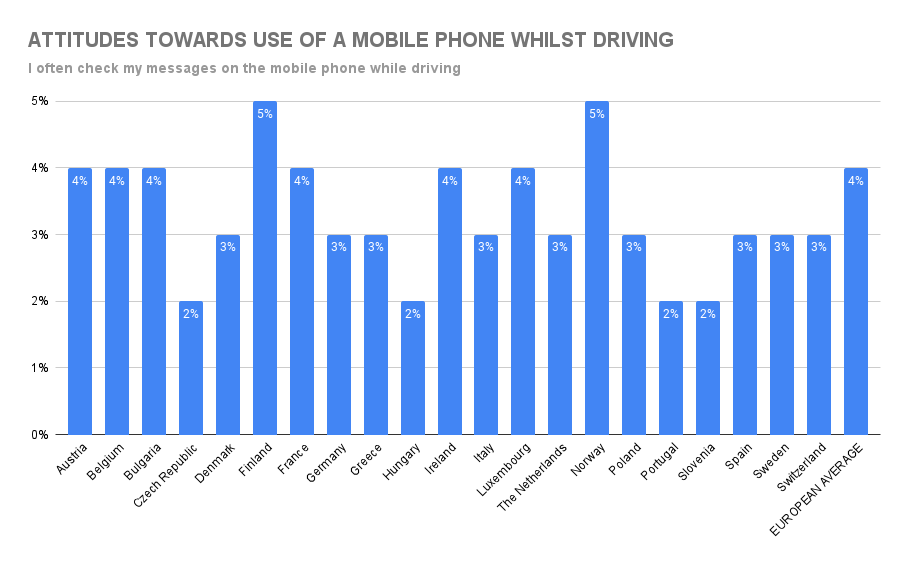
| ATTITUDES TOWARDS USE OF A MOBILE PHONE WHILST DRIVING | |
|---|---|
| I often check my messages on the mobile phone while driving | |
| Austria | 4% |
| Belgium | 4% |
| Bulgaria | 4% |
| Czech Republic | 2% |
| Denmark | 3% |
| Finland | 5% |
| France | 4% |
| Germany | 3% |
| Greece | 3% |
| Hungary | 2% |
| Ireland | 4% |
| Italy | 3% |
| Luxembourg | 4% |
| The Netherlands | 3% |
| Norway | 5% |
| Poland | 3% |
| Portugal | 2% |
| Slovenia | 2% |
| Spain | 3% |
| Sweden | 3% |
| Switzerland | 3% |
| EUROPEAN AVERAGE | 4% |
- As the graph shows, the European average for people who admit they often check messages while driving is 4%.
- Finland and Norway are the worst culprits, with 5% each, while Czech Republic, Hungary, Portugal, and Slovenia, are lowest with 2% each.
“I will do my best not to use my mobile phone while driving in the next 30 days.”
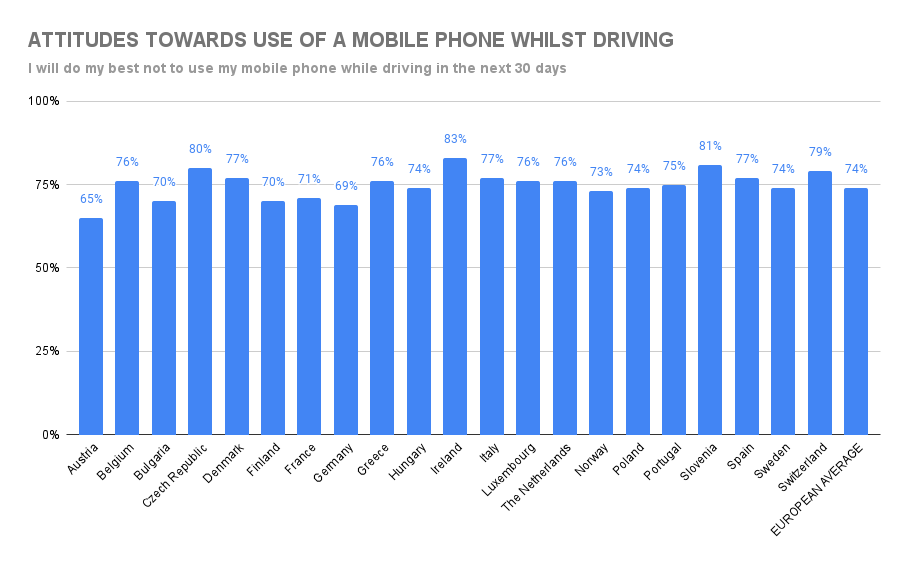
| ATTITUDES TOWARDS USE OF A MOBILE PHONE WHILST DRIVING | |
|---|---|
| I will do my best not to use my mobile phone while driving in the next 30 days | |
| Austria | 65% |
| Belgium | 76% |
| Bulgaria | 70% |
| Czech Republic | 80% |
| Denmark | 77% |
| Finland | 70% |
| France | 71% |
| Germany | 69% |
| Greece | 76% |
| Hungary | 74% |
| Ireland | 83% |
| Italy | 77% |
| Luxembourg | 76% |
| The Netherlands | 76% |
| Norway | 73% |
| Poland | 74% |
| Portugal | 75% |
| Slovenia | 81% |
| Spain | 77% |
| Sweden | 74% |
| Switzerland | 79% |
| EUROPEAN AVERAGE | 74% |
- Data shows that a lot of people will endeavour not to use their mobile phone when driving. 83% of Ireland’s drivers promised to do this; the largest percentage in Europe.
- Only 65% of Austrians are happy to pledge towards less phone use while driving.
Texting and Driving Statistics: Just Don’t Do It
The above statistics are damning. If you use a phone while you are driving, you are at a much greater risk of causing a fatal accident than if you have your attention on the road at all times. So, if you are making a journey in the car, wait until you reach your destination before you start texting. Or, at the very least, pull over when it is safe to do so. Texting and driving at the same time is incredibly dangerous.
